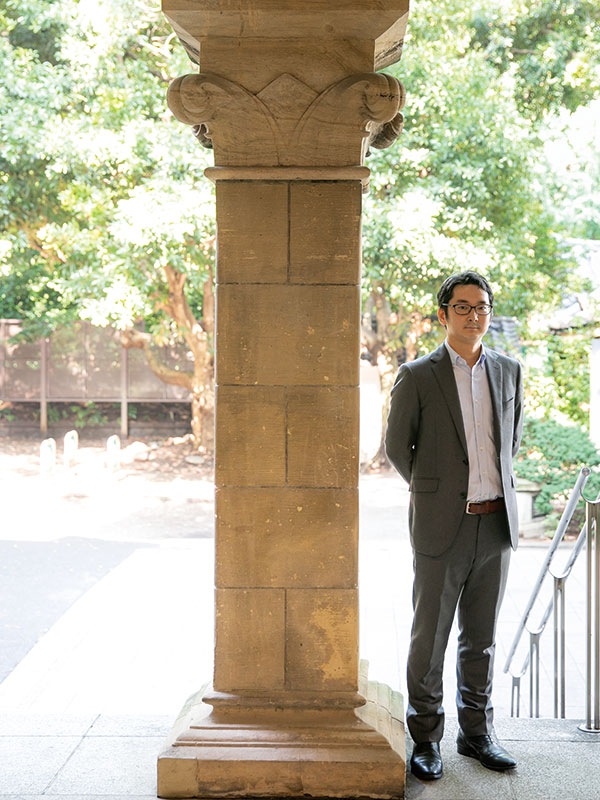Uncovering contemporary innovation on the ground in China

UTokyo 30s
Up-and-coming young researchers
Of the approximately 5,800 faculty members active at the University of Tokyo, we have selected nine energetic young researchers in their 30s. In terms of their job titles, there is one professor, two associate professors, one project associate professor, one lecturer, one project lecturer and three research associates. What kind of research are they engaged in day to day? And what is their temperament like? Let’s find out.
| Economics of Modern China |
Uncovering contemporary innovation on the ground in China
 Asei Ito Asei ItoAssociate Professor, Institute of Social Science |

China is the world’s second largest economy and its domestic industrial trends have drawn worldwide attention. Associate Professor Asei Ito’s aim is to practice the “best mix” in terms of the empirical study and theoretical interpretation of the Chinese economy.
His decision to study the Chinese economy at Keio University's Faculty of Economics was prompted by his attraction to Japan’s “skyrocketing” neighbor, which recorded double-digit GDP growth in the early 2000s.
For a year from summer 2006 when he participated in a visiting program, Ito studied at Renmin University of China in Beijing. During his stay, Ito experienced first-hand the vibrant atmosphere of the country as China’s economy went through a period of rapid economic growth right before the Olympic Games. Since then, he has traveled to China many times as a visiting student and to conduct surveys. His current research is informed by his experience of embedded language study and of conducting field surveys in China, especially his survey of manufacturing sites that have been dubbed the “Factory of the World.”
“On a tour of countryside factories, I saw a sock factory that had as many as 8,000 employees and machines lined up as far as my eye could see, which I thought was an astonishing sight. When I asked how many pairs of socks they made, they said it was about a billion pairs a year. That was a huge shock for me.”
In the world’s largest general merchandise market, located in the city of Yiwu in Zhejiang province, known as the “Dollar Store Town,” Ito carried out an audacious questionnaire survey on foreign buyers. The survey clarified factors that have expanded the market for all manner of goods – from toys to accessories, from clothing to furniture – in terms of the robustness of their assortment, affordability and trading flexibility, and that have attracted buyers from around the world.
On the other hand, economic evidence is also essential. “Whether the pattern of China’s economic development is standard or distinct as compared to conventional models of development is an extremely important question.”
Ito’s laboratory at the Institute of Social Science, where he has been an associate professor since 2017, features a variety of Chinese products including a picture frame whose contents change with digital signage, a Xiaomi robot vacuum that resembles the Roomba, and a drone by DJI. Ito, who says that the pursuit of economic trends on the front lines “inspires his research,” believes that aside from writing research papers, it is also important to disseminate information by other means.
“It takes about two years to conduct a survey, write it up and get it published after sending it out for peer review. But the situation in China is changing rapidly. These days we can release our findings directly via Internet media, and the hurdles to planning an event have been lowered. In the wider society, researchers are being called upon for broader outputs. Sometimes following a Chinese company will lead you to Ethiopia. Communicating via these kinds of new channels is also becoming a necessity.”
| Q & A | |
|---|---|
| How has your life changed compared to your twenties? | “I’ve stopped being anxious about my situation from year to year, and I’m now thinking about what kind of researcher I want to be when I’m 40.” |
| What do you do with your off time? | “Our kids love aquariums, so we take them there on the weekends.” |
| Who is the figure on your bookshelf? | That’s Bilibili Girl 33, a character from Bilibili, a video sharing website in China.” |
| What two economists would you say have been influential for you personally? | “In terms of theory, Katsuji Nakagane. In the sense of field-based practice, Akira Suehiro.” |
| Books authored and edited by Associate Professor Asei Ito: Gendai Chugoku no Sangyo Shuseki (“Industrial Clusters in Contemporary China”) (The University of Nagoya Press, 2015; ¥5,400 + tax) The Asian Economy: Contemporary Issues and Challenges, edited by Kenta Goto, Tamaki Endo, and Asei Ito, Routledge, 2020. |
* This article was originally printed in Tansei 39 (Japanese language only). All information in this article is as of September 2019.






